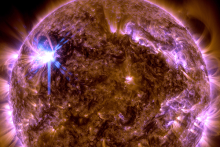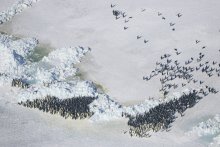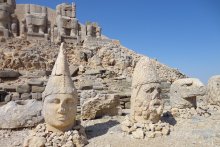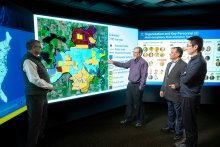News

U of M researchers lead NASA’s first solar flare observation campaign
Posted
For the first time, a team of researchers from the University of Minnesota Twin Cities launched a sounding rocket to study solar flares in real time.

High resolution imagery gives new insight into emperor penguin population
Posted
An international team, including a University of Minnesota researcher, has released a first-of-its-kind new study that gives insight into the population of emperor penguins in Antarctica.

New study is first step in predicting carbon emissions in agriculture
Posted
For the first time, researchers at the University of Minnesota Twin Cities (UMN) and the University of Illinois Urbana-Champaign (UIUC) have demonstrated that it is possible to provide accurate, high-resolution predictions of carbon cycles in agroecosystems, which could help mitigate the impacts of climate change.

University of Minnesota selected as NSF Convergence Accelerator Phase 1 awardee for chemical water sensing
Posted
The University of Minnesota team is developing Aquasense, a low-cost, compact, easy-to-use, rapid water quality sensor platform enabled by artificial intelligence (AI).

Expert Alert: Iceland earthquakes may be warning of impending volcanic eruption
Posted
CSE Professor Justin Revenaugh can comment on the current situation. A state of emergency was declared this week for Iceland, as the area prepares for a possible volcanic eruption. So far, thousands of earthquakes have been recorded in the area, which has led to evacuations in Grindavik. Experts at the Icelandic Meteorological Office say that there is a “significant likelihood” of an eruption in the coming days.

Two U of M-affiliated projects named as finalists in NSF Regional Innovation Engine Competition
Posted
University of Minnesota College of Science and Engineering researchers are part of two proposed sustainability projects chosen as finalists for the National Science Foundation’s (NSF) Regional Innovation Engines competition.

Researchers unearth the mysteries of how Turkey’s East Anatolian fault formed
Posted
An international team led by the University of Minnesota Twin Cities has, for the first time, accurately determined the age of the East Anatolian fault, allowing geologists to learn more about its seismic history and tendency to produce earthquakes.

University of Minnesota to lead new $20M AI Institute focusing on climate-smart agriculture and forestry
Posted
The University of Minnesota Twin Cities received a $20 million grant from the National Science Foundation and the USDA National Institute of Food and Agriculture to lead a new research institute that will leverage artificial intelligence to help absorb and store carbon in farms and forests.

U of M researchers develop technique for rapid detection of neurodegenerative diseases like Parkinson’s and Chronic Wasting Disease
Posted
University of Minnesota Twin Cities researchers have developed a groundbreaking new diagnostic technique that will allow for faster and more accurate detection of neurodegenerative diseases that affect humans, such as Alzheimer's and Parkinson's, and similar diseases that affect animals, such as chronic wasting disease (CWD) and mad cow disease.

Professor Larry Edwards receives Benjamin Franklin Medal in Earth and Environmental Sciences
Posted
University of Minnesota Twin Cities Professor R. Lawrence “Larry” Edwards has been awarded the Franklin Institute’s 2023 Benjamin Franklin Medal in Earth and Environmental Sciences recognizing his achievements in the field.
